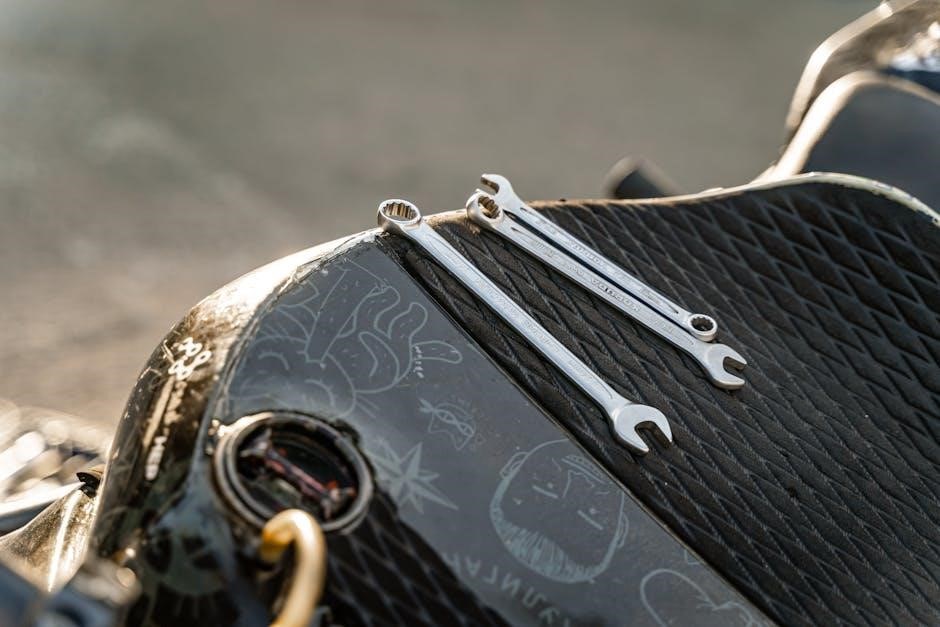Converting a BMW E46 from automatic to manual transmission offers enhanced driving control and performance. The process involves replacing the automatic gearbox with a manual transmission, such as the Getrag 250G or ZF GS6-37BZ, and requires careful planning, mechanical expertise, and electrical adjustments to ensure proper functionality and integration with the vehicle’s systems.

Planning and Preparation
Planning an E46 auto-to-manual swap requires assessing the project’s complexity, budgeting for parts, and ensuring compatibility; Research transmission options, driveshaft needs, and clutch components. Consider labor costs and tools required for a successful conversion.
Choosing the Right Manual Transmission
Selecting the appropriate manual transmission for your E46 is crucial for a seamless swap. The Getrag 250G and ZF GS6-37BZ are popular choices, each offering distinct gear ratios and compatibility. The Getrag 250G is ideal for smaller engines, providing smooth shifts and optimal performance. In contrast, the ZF GS6-37BZ, commonly found in higher-performance models, offers a six-speed configuration with closer ratios, enhancing acceleration and drivability. Both transmissions require specific driveshafts and mounting hardware, so ensure compatibility with your vehicle’s specifications. Additionally, considerations such as the differential ratio and clutch setup must align with the chosen transmission to maintain proper gear engagement and overall performance. Researching these factors ensures a well-suited transmission for your E46, avoiding potential mechanical mismatches and ensuring a successful swap.

Understanding the Mechanical Swap
Understanding the mechanical swap involves replacing the automatic transmission with a manual gearbox, driveshaft, and clutch. Compatibility with the vehicle’s differential and gear ratios is essential for optimal performance and smooth operation.
Removing the Automatic Transmission
Begin by draining the transmission fluid and disconnecting the battery to ensure safety. Remove the air intake duct and other components for better access. Disconnect the transmission mounts and support the transmission with a jack. Remove the driveshaft, marking it for proper realignment later. Disconnect electrical connectors and fluid lines, labeling them for future reference. Remove the torque converter, which is bolted to the flywheel. Finally, remove the transmission bolts and carefully lower the transmission out of the car using a transmission jack or with assistance. Document each step to facilitate reinstallation when swapping in the manual transmission. Consult repair manuals or online forums for specific instructions and tips to avoid common mistakes.
Installing the Manual Transmission
Once the automatic transmission is removed, position the manual transmission under the car, aligning the bellhousing with the engine. Use a transmission jack for stability and safety. Reattach the mounts and secure the transmission with the appropriate bolts, ensuring they are tightened to the correct torque specifications. Reinstall the driveshaft, making sure the markings align for proper balance. Attach the clutch slave cylinder and master cylinder, reconnecting the hydraulic lines carefully to avoid air bubbles. Reconnect all electrical connectors, including those for the reverse light and speed sensor. Replace the torque converter with a clutch system, ensuring the flywheel is properly aligned. Finally, test the clutch pedal feel and ensure all components are securely fastened. Proper alignment and secure installation are critical for smooth transmission operation and to prevent future mechanical issues.

Electrical and Wiring Modifications
Converting to a manual transmission requires updating the car’s wiring to remove dependencies on the automatic transmission control module. This involves disconnecting the automatic transmission’s electronic controls and integrating the manual transmission’s sensors and switches, such as the clutch pedal position sensor and reverse light switch, ensuring proper communication with the vehicle’s ECU for functions like engine control and reverse light activation. Additionally, the removal of the automatic transmission control module (EGS) and its associated wiring is necessary to prevent interference and ensure the car operates correctly with the new manual setup. These modifications are essential for maintaining proper vehicle functionality and preventing potential electrical issues, ensuring the car’s systems operate seamlessly with the manual transmission. Proper electrical integration is crucial for a successful swap and should be handled by someone with experience in automotive wiring and electronics to avoid complications and ensure safety.
Wiring Changes for Manual Transmission
When converting the E46 from automatic to manual, significant wiring changes are necessary to adapt the vehicle’s electrical systems. The primary step involves removing the automatic transmission control module (EGS) and disconnecting its associated wiring, particularly the A7000 connector. This eliminates the car’s reliance on the automatic transmission’s electronic controls. A key modification is integrating the clutch pedal sensor, which informs the ECU about clutch engagement, ensuring proper engine control during manual shifting. Additionally, the reverse light switch must be connected to the manual transmission to activate the reverse lights, a function previously managed by the automatic transmission’s control module. The wiring harness may also need adjustments to accommodate the manual transmission’s sensors and switches. These changes require careful attention to avoid electrical faults and ensure the car operates smoothly with the new manual setup. Detailed wiring diagrams and specialized tools, such as NCS Expert, are often necessary to reprogram the ECU and complete the electrical integration successfully. Proper execution of these wiring modifications is critical for a seamless and functional auto-to-manual conversion.

Coding and Programming
Coding and programming are critical steps in the E46 auto-to-manual swap to ensure the vehicle’s systems recognize and function with the manual transmission. The primary goal is to update the car’s ECU to remove automatic transmission-specific codes and enable manual transmission operation. Using tools like NCS Expert or PA Soft, enthusiasts can disable the automatic transmission control module (EGS) and remove associated codes, such as the 205 code, which prevents the car from starting without an automatic transmission. Additionally, the clutch switch must be disabled to eliminate warnings related to the missing clutch pedal in automatic mode. Coding also involves configuring reverse light functionality, as manual transmissions use a direct signal from the gearbox, unlike automatics, which rely on the EGS module. Proper coding ensures the car starts and runs smoothly, with all systems functioning as intended. It’s highly recommended to consult a professional or use detailed guides to avoid errors that could result in costly repairs or operational issues.
Testing and Fine-Tuning
After completing the manual transmission swap, thorough testing and fine-tuning are essential to ensure everything operates smoothly. Start with a series of short drives to assess clutch engagement, gear shifts, and overall drivetrain functionality. Pay attention to any unusual noises, vibrations, or difficulties in shifting gears, which could indicate issues with the transmission, drivetrain, or clutch alignment. Check the reverse lights to confirm they activate correctly, as this function is directly tied to the manual transmission’s signal. Fine-tune the clutch pedal adjustment to achieve the optimal bite point for smooth engagement. Additionally, verify that all electrical modifications, such as wiring changes, are functioning as intended. If any problems arise, address them promptly to prevent further complications. Once everything performs flawlessly, the swap is complete, and the vehicle is ready to deliver the enhanced driving experience of a manual transmission.
The E46 auto-to-manual swap is a rewarding yet complex modification that transforms the driving experience. By replacing the automatic transmission with a manual gearbox, drivers gain enhanced control and a more engaging connection to the vehicle. The process requires meticulous planning, mechanical expertise, and attention to electrical and wiring details. While challenging, the end result is a car that delivers improved performance and driver satisfaction. For those willing to invest time and effort, the swap offers a sense of accomplishment and a more immersive driving experience. Proper testing and fine-tuning are critical to ensure reliability and optimal functionality. Whether for enthusiast enjoyment or performance gains, the E46 manual conversion is a worthwhile endeavor for those passionate about driving dynamics. With careful execution, the swap not only enhances the car but also deepens the bond between driver and machine.

